The Supersport market is changing, and if machines like the 2020 Triumph Daytona Moto2 765 Limited Edition are the segment’s future, it’s not a moment too soon.
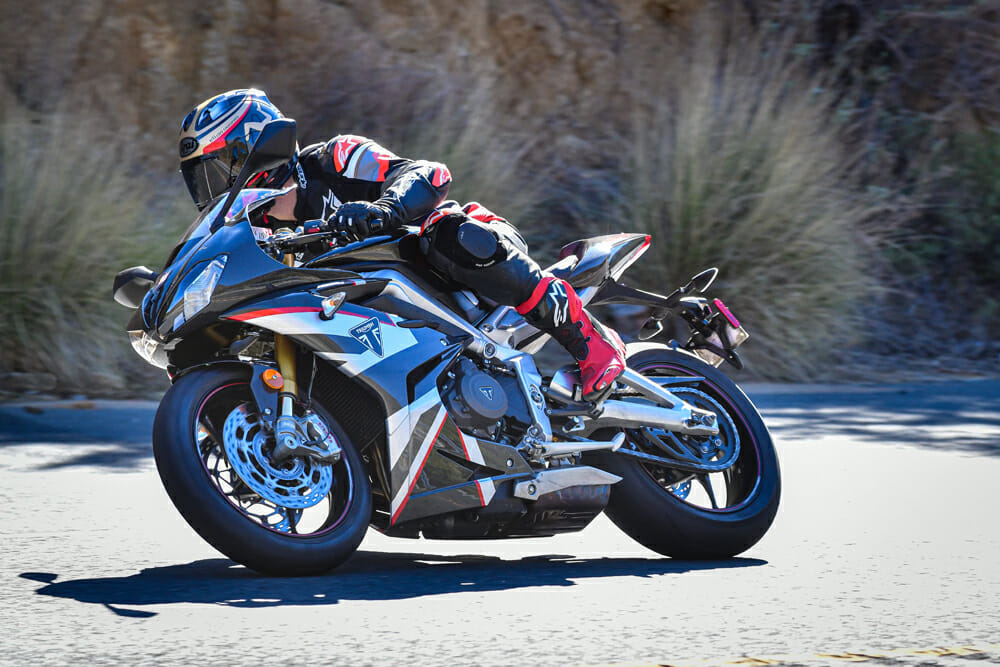
Photography by Kit Palmer
The supersport segment is morphing into one that properly represents what’s going on in the market. The 600cc fours are as good as dead, and the new machines coming in, such as the Ducati Panigale V2 or the Triumph Daytona Moto2 765 Limited Edition, will make up supersport grids in years to come. And it can’t happen soon enough.
That’s my first thought as I rip up Ortega Highway in Southern California on the only American press unit of the 2020 Triumph Daytona Moto2 765 Limited Edition. At $17,500 MSRP, this is the first motorcycle to be licensed by MotoGP commercial rights holders Dorna and limited to 765 units for the North American market (including Canada), along with 765 units for the rest of the world.
Weighing a measured 409 pounds with a full tank of gas, the 765 is a visually stunning machine, one that has a lure to it you simply cannot deny. There’s carbon fiber everywhere—seat unit, fairing, front and rear wheel guards, even in the cockpit where the woven black material covers the back of the light assembly, flanking either side of the TFT dash.
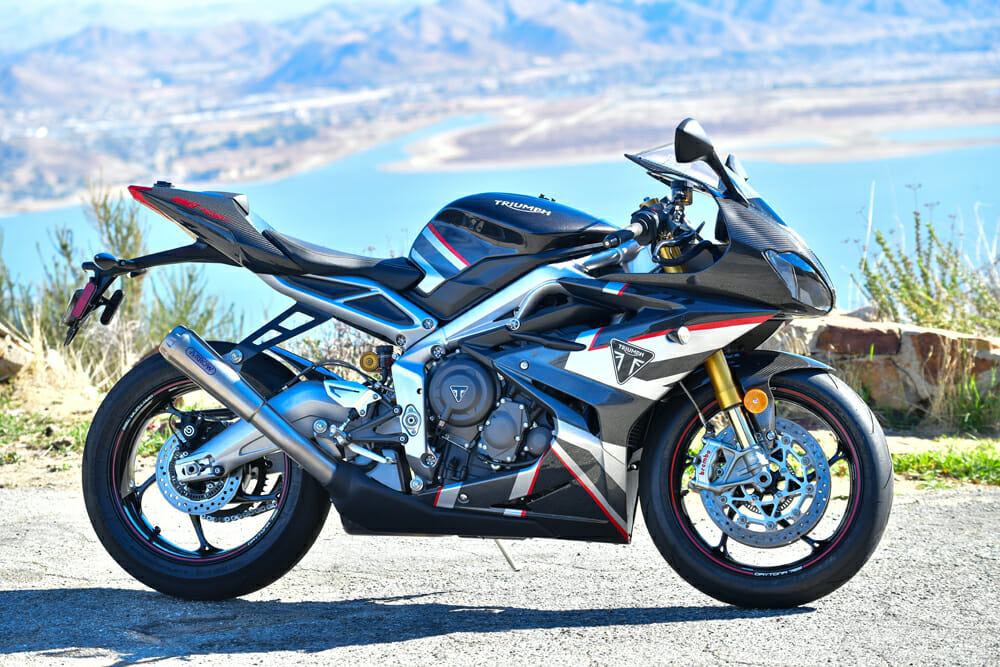
There’s further evidence of the Daytona’s exclusiveness in the beautiful finish of the top triple clamp with your specific model number stamped just behind the key barrel, the single-seat unit emblazoned with the Moto2 logo with zero provisions for a passenger, and the neat stitching of the seat pad itself.
The carbon conceals a 128 horsepower, 765cc, inline three-cylinder motor developed as the control engine for the Moto2 World Championship. While it doesn’t have quite the 150 or so horsepower the Moto2 racers have at their disposal, the street Daytona produces a near perfect torque curve that starts from barely 2000 rpm onwards to the 12,250 rpm redline.
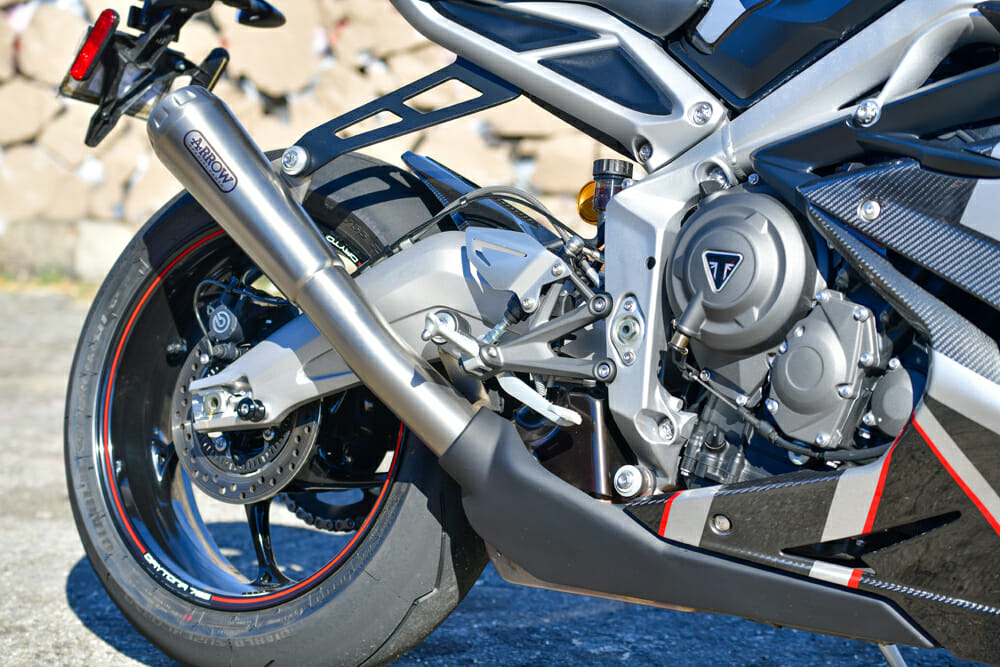
It’s a special engine produced by Triumph. Inside sit titanium inlet valves, redesigned pistons, the same piston pins used in the Moto2 engines, revised camshaft profiles, intake trumpets and port, con-rods, crank and the cylinder barrels themselves. Interestingly, the engine’s compression is down from 13.1:1 to 12.9:1.
Triumph has also increased the revs by 600 rpm to redline, which now stands at 13,250 rpm.
Unlike the Daytona’s four-cylinder class counterparts, the 765cc triple produces power pretty much everywhere. It’s a seriously flexible motor, although there are still some race genes in there that love to see revs north of 7000 rpm. This is the happy spot for road riding, and right at the tip of the performance iceberg for track riding. The Daytona possesses five different riding modes—Rain, Road, Rider Configurable, Sport and Track—and I settled on the preset Sport mode for my couple of weeks of street cruising. Track mode gives an even more direct throttle response than Sport, but the Sport mode softens the initial power delivery a touch for better street manners.
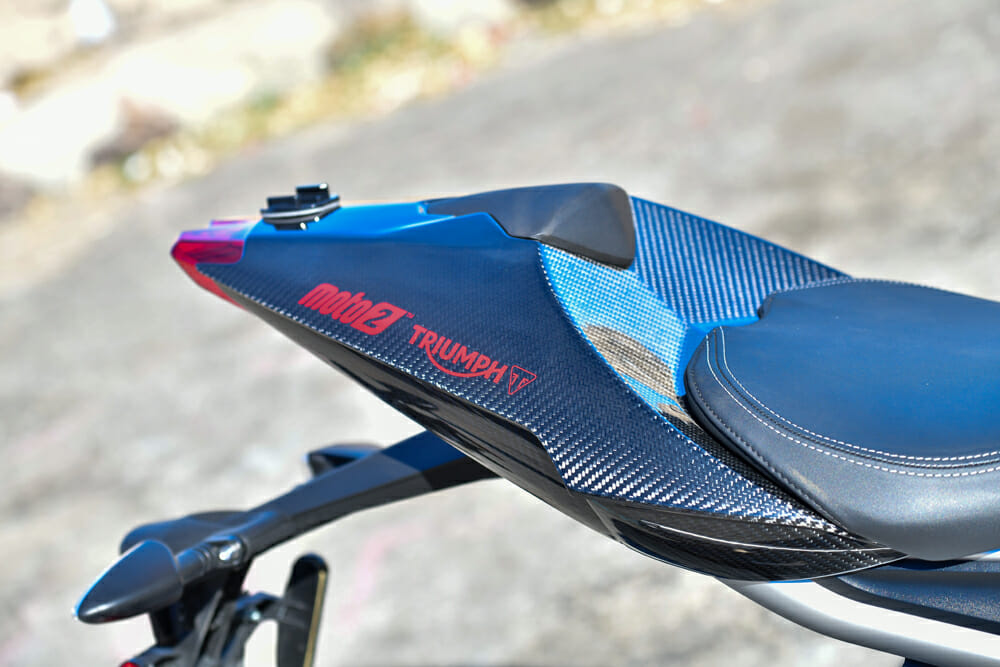
Getting those spent gasses out is the job of probably the best-looking exhaust pipe currently available on a production motorcycle. The Arrow titanium race can looks more like a musical instrument than an exhaust pipe, and Triumph has managed to keep the audio police at bay while still giving the rider just enough of that beautiful three-cylinder roar to keep them interested.
The Arrow can is mated to a traditional three-into-one system that houses a pretty huge catalytic convertor, something that’s no doubt a source of extra weight the race bikes of the future will get rid of immediately.
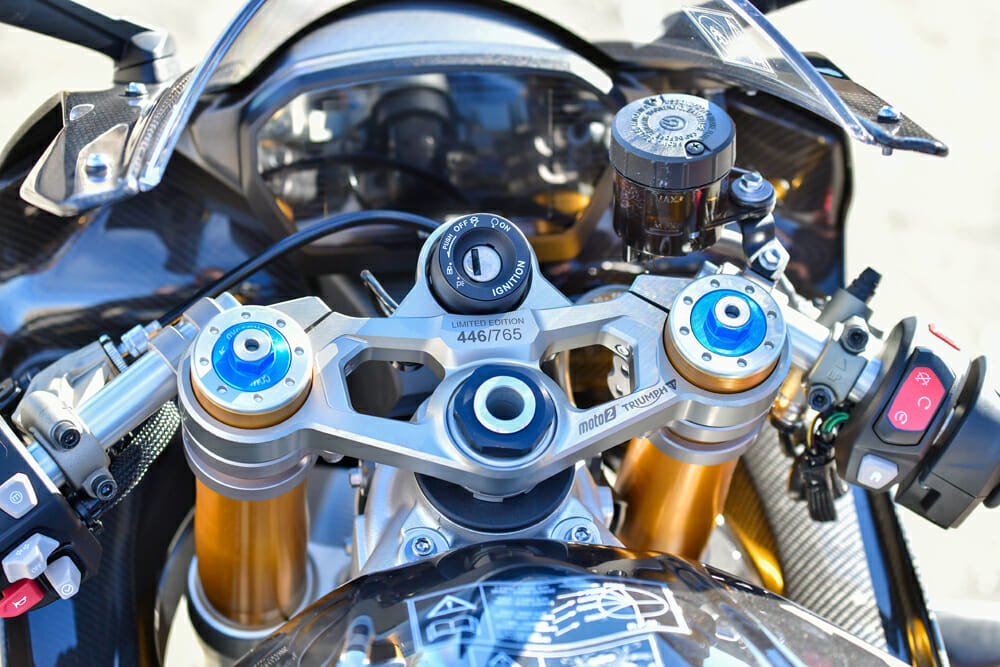
By far, one of the best features on the Daytona Moto2 machine is the gearbox. I’ll go as far as to say this is the sweetest production gearbox I’ve tried in the last 12 months. The close-ratio system has a delightfully short throw, and when mated to the Triumph quickshifter fitted as standard, you feel like a Moto2 racer as you rip through the gears and hear the popping of the three-cylinder motor, whether up or down shifting.
Part of the reason the gearbox stands out so well is not just the shifting itself, but also the way Triumph engineers and test riders have worked the electronics to give near perfect rev matching on the downshift. This makes it super easy to bang back through the gears, lean on the slipper clutch and throw the Daytona into a bend without everything getting all out of line. It’s a beautiful experience.
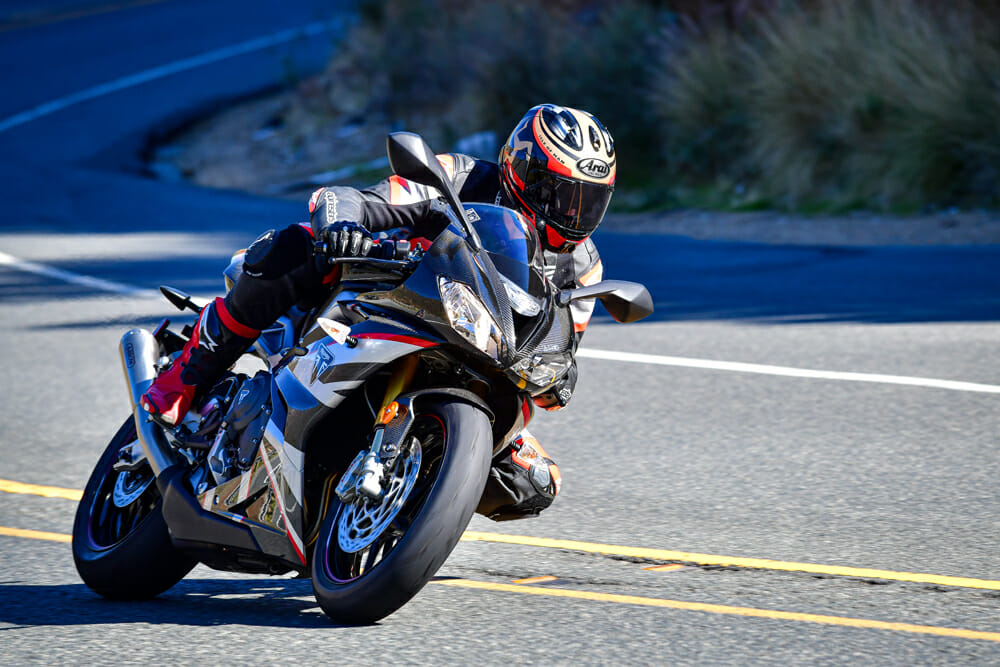
The Daytona weighs 409 pounds ready to ride with a full 4.6 gallons of gas on the Cycle News scales, the lightest ever production Daytona. It carries its weight superbly well, thanks to top-spec Ӧhlins NIX30 forks and a TTX36 shock out back. Thankfully, Triumph has kept the Daytona’s suspension totally analog, so no semi-active elements are present.
I’ve said for years that well set-up, high-quality analog suspension always trumps digital/electronic units, and the Triumph is no different. Ride quality is firm but still compliant in road settings, although riders north of 190 pounds will probably want a few turns of preload to help the rear stay up on the exit of corners.
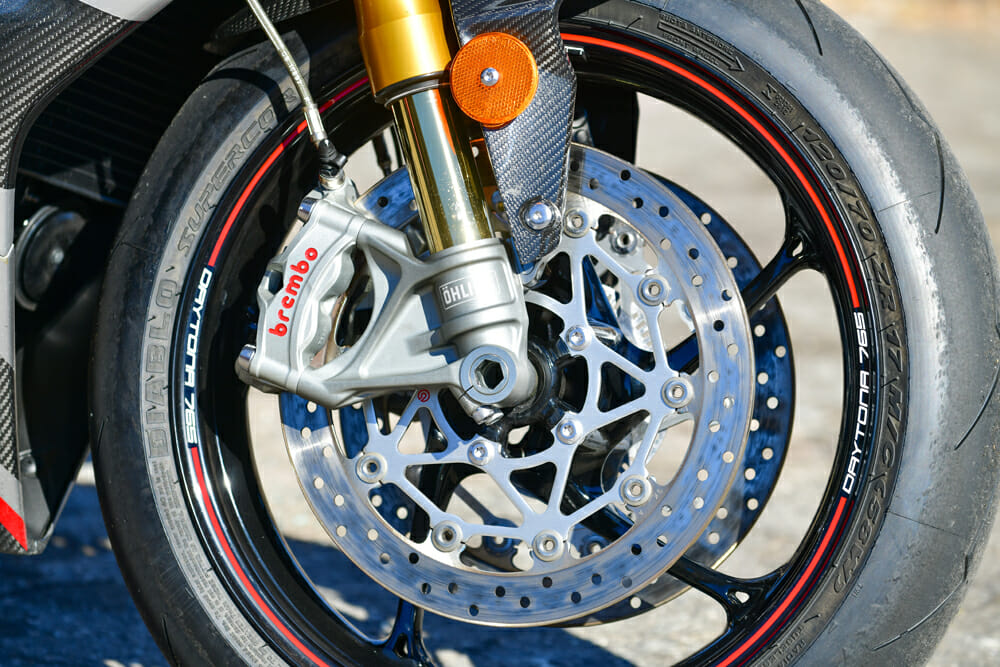
That said, you can ride the Daytona with the kind of abandon its namesake suggests. Under brakes and through the first stages of cornering, the Daytona’s front-end talks to the rider, offering sublime feel and road holding. Helping this point is the Pirelli Diablo Supercorsa SP V3, which is the Italian company’s premier road tire before you start getting into the race-spec Supercorsa SC range. The SP’s heat up quickly and offer huge amounts of grip and feel, but are likely to wear a little faster than something like the more street-focused Diablo Rosso Corsa II tire, if longevity is of any concern.
On top of the Ӧhlins package, you have my second favorite part of the Daytona: the front brakes. This is a $17,500 MSRP machine, so you’d expect the Triumph engineers to fit half-decent brakes, which they most certainly have. At your disposal is a Brembo MCS radial-master-cylinder mated to dual Brembo Stylema four-piston radial calipers that grip 310mm discs. Those last two parts of caliper and discs are not much different to the ones you’ll get on other high-spec performance bikes, but it’s the feel at the lever that Triumph has managed to coax out of the system that makes the difference. A good master-cylinder is the key, and thankfully Triumph hasn’t skimped on this vitally important part of the performance package.
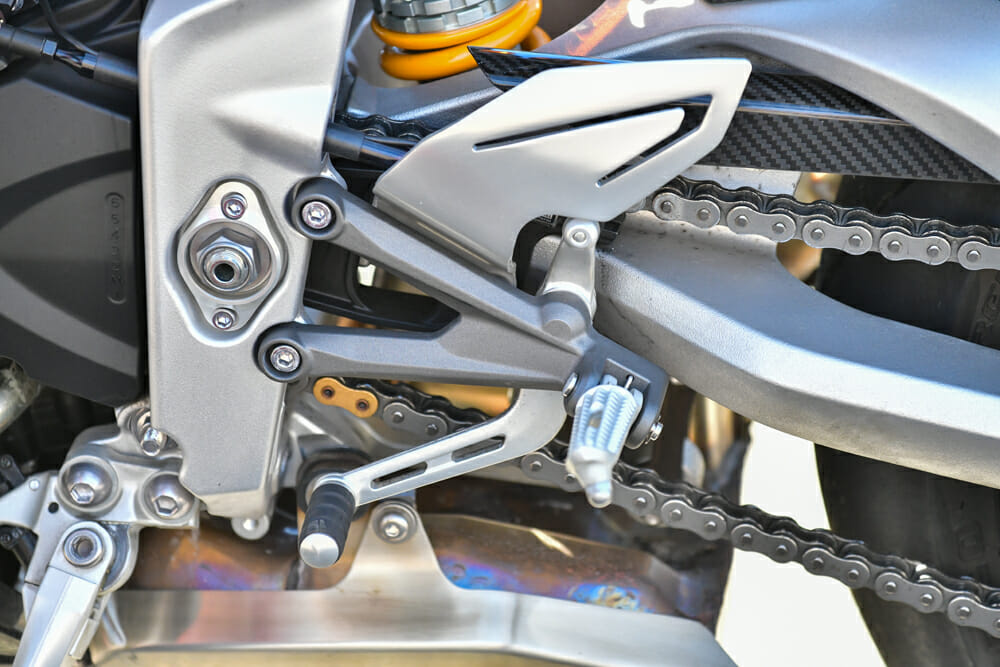
Triumph has not fitted cruise control to the 765, which is a little disappointing for a bike costing nearly $18K. However, the user interface for the dash is one of the best on the market today. Triumph has been a leader now for a few years in user interface experience, going back to the Street Triple 675 of 2017. The Daytona takes things a step further, with easy access to the information you need at a glance and nothing you don’t. Everything is accessed by the joystick on the left handlebar, giving you access to the traction control, ABS and various ride settings and multiple dash layouts. Triumph has kept the design nice and neat, fitting in with the Daytona’s minimalist race ethos.
The 2020 Triumph Daytona Moto2 765 Limited Edition may indeed be limited, but its importance cannot be overstated for the supersport category. As the class gets faster and larger capacity bikes become the norm, the 765 will no doubt be one of the staples in the coming years, especially if Triumph starts producing a Daytona that isn’t a limited edition.
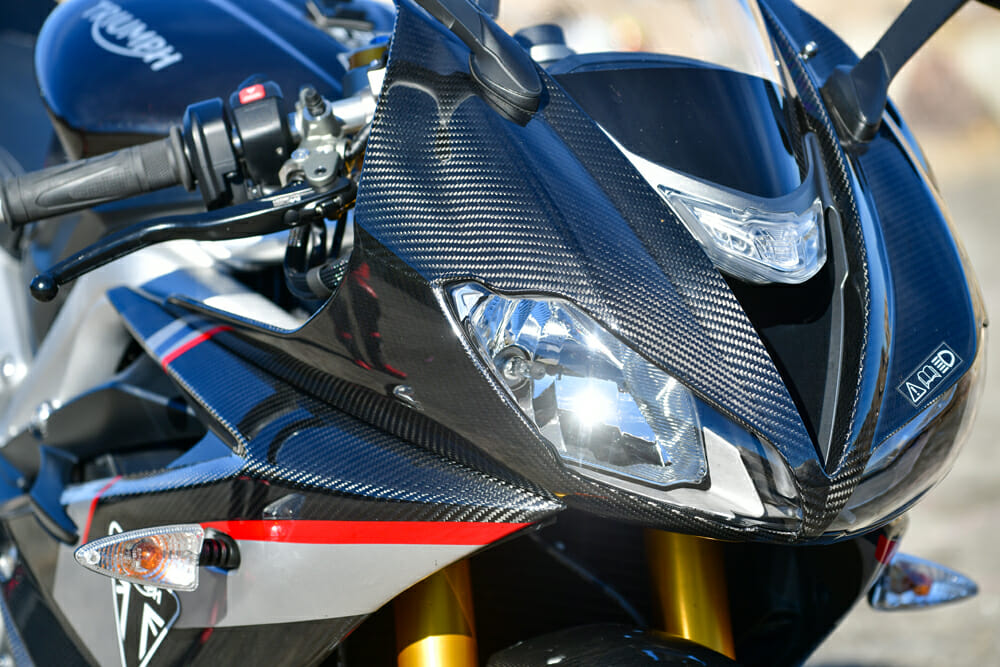
This version, however, is a splendid one indeed. There’s performance in spades and looks to kill, and if you’re one of the 765 customers who will pick up a Daytona in North America, you’re going to have fun on this for many years to come. CN
VIDEO | 2020 Triumph Daytona Moto2 765 Limited Edition Review
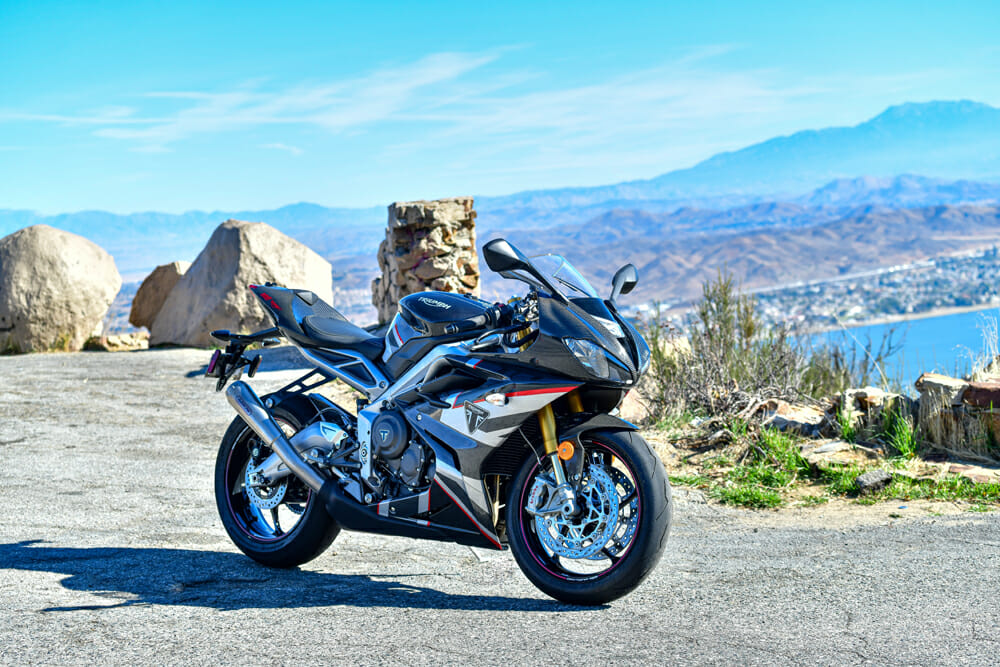
2020 Triumph Daytona Moto2 765 Limited Edition Specifications
| MSRP: | $17,500 |
| Engine: | Three-cylinder 4-stroke |
| Valvetrain: | 12 valves, DOHC |
| Cooling system: | Liquid |
| Displacement: | 765cc |
| Bore x stroke: | 78 x 53.3mm |
| Compression ratio: | 12.9:1 |
| Power (claimed): | 128 hp at 12,250 rpm |
| Torque (claimed): | 59 lb-ft at 9750 rpm |
| Exhaust: | 3 into 1 |
| Transmission: | 6-speed with quickshift |
| Clutch: | Multi-plate wet clutch with mechanical slip system |
| Electronics: | Traction control, ABS with race mode, five engine maps |
| Chassis: | Aluminum twin-spar |
| Front suspension: | Öhlins 43mm inverted NIX30 fork, fully adjustable |
| Rear suspension: | Öhlins TTX30 monoshock, fully adjustable |
| Front brake: | Brembo Stylema radial 4-piston calipers, dual 320mm discs, ABS |
| Rear brake: | 1 piston Brembo caliper, single 220mm disc, ABS |
| Front tire: | 120/70 – ZR 17 Pirelli Supercorsa SP |
| Rear tire: | 180/55 – ZR 17 Pirelli Supercorsa SP |
| Wheelbase: | 54.3 in. |
| Seat height: | 32.36 in. |
| Fuel capacity: | 4.6 gal. |
| Weight (wet, measured): | 403 lbs. |
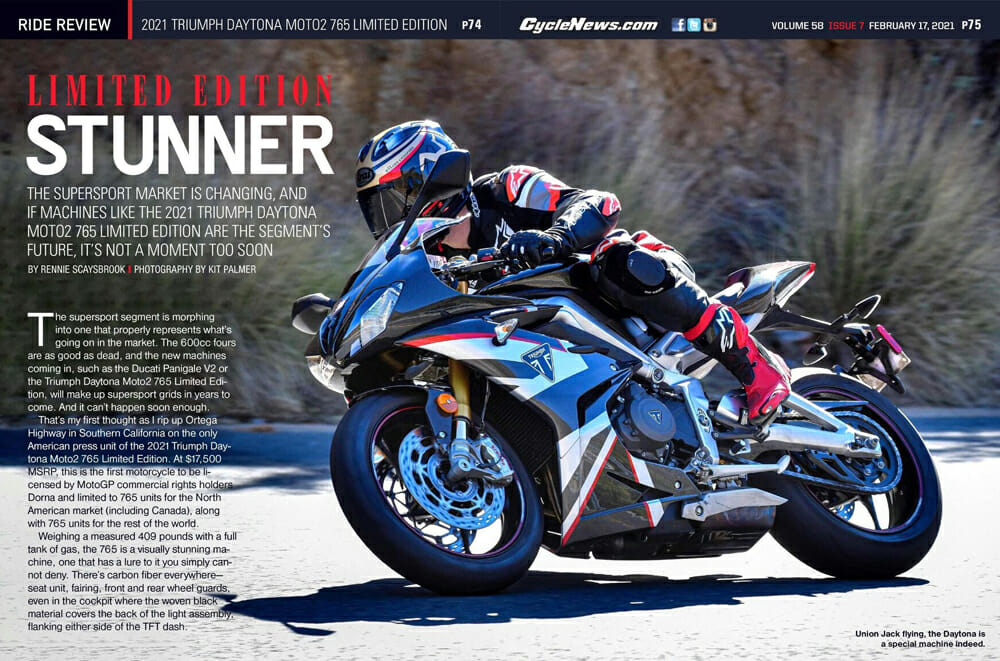
Click here to read the 2020 Triumph Daytona Moto2 765 Limited Edition Review in the Cycle News Digital Edition Magazine.
Click here for the latest Cycle News Sportbike motorcycle reviews and news.
Click here for more Triumph motorcycle reviews and news.
